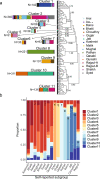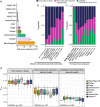Fine-scale population structure and demographic history of British Pakistanis
- PMID: 34893604
- PMCID: PMC8664933
- DOI: 10.1038/s41467-021-27394-2
Fine-scale population structure and demographic history of British Pakistanis
Abstract
Previous genetic and public health research in the Pakistani population has focused on the role of consanguinity in increasing recessive disease risk, but little is known about its recent population history or the effects of endogamy. Here, we investigate fine-scale population structure, history and consanguinity patterns using genotype chip data from 2,200 British Pakistanis. We reveal strong recent population structure driven by the biraderi social stratification system. We find that all subgroups have had low recent effective population sizes (Ne), with some showing a decrease 15‒20 generations ago that has resulted in extensive identity-by-descent sharing and homozygosity, increasing the risk of recessive disorders. Our results from two orthogonal methods (one using machine learning and the other coalescent-based) suggest that the detailed reporting of parental relatedness for mothers in the cohort under-represents the true levels of consanguinity. These results demonstrate the impact of cultural practices on population structure and genomic diversity in Pakistanis, and have important implications for medical genetic studies.
© 2021. The Author(s).
Conflict of interest statement
The authors declare no competing interests.
Figures






Similar articles
-
A method for distinguishing consanguinity and population substructure using multilocus genotype data.Mol Biol Evol. 2001 Nov;18(11):2048-56. doi: 10.1093/oxfordjournals.molbev.a003746. Mol Biol Evol. 2001. PMID: 11606701
-
ENDOGAMY, CONSANGUINITY AND THE HEALTH IMPLICATIONS OF CHANGING MARITAL CHOICES IN THE UK PAKISTANI COMMUNITY.J Biosoc Sci. 2017 Jul;49(4):435-446. doi: 10.1017/S0021932016000419. Epub 2016 Aug 30. J Biosoc Sci. 2017. PMID: 27573732
-
Genomic runs of homozygosity record population history and consanguinity.PLoS One. 2010 Nov 15;5(11):e13996. doi: 10.1371/journal.pone.0013996. PLoS One. 2010. PMID: 21085596 Free PMC article.
-
Drivers of cousin marriage among British Pakistanis.Hum Hered. 2014;77(1-4):26-36. doi: 10.1159/000358011. Epub 2014 Jul 29. Hum Hered. 2014. PMID: 25060267 Free PMC article. Review.
-
Endogamy, consanguinity and community genetics.J Genet. 2002 Dec;81(3):91-8. doi: 10.1007/BF02715905. J Genet. 2002. PMID: 12717037 Review.
Cited by
-
Exome sequencing of UK birth cohorts.Wellcome Open Res. 2024 Dec 5;9:390. doi: 10.12688/wellcomeopenres.22697.2. eCollection 2024. Wellcome Open Res. 2024. PMID: 39839975 Free PMC article.
-
South Asia: The Missing Diverse in Diversity.Behav Genet. 2024 Jan;54(1):51-62. doi: 10.1007/s10519-023-10161-y. Epub 2023 Nov 2. Behav Genet. 2024. PMID: 37917228 Free PMC article. Review.
-
Genetic Screening of a Nonsyndromic Amelogenesis Imperfecta Patient Cohort Using a Custom smMIP Reagent for Selective Enrichment of Target Loci.Hum Mutat. 2025 Jul 22;2025:8942542. doi: 10.1155/humu/8942542. eCollection 2025. Hum Mutat. 2025. PMID: 40741335 Free PMC article.
-
Parent-offspring inference in inbred populations.Mol Ecol Resour. 2022 Nov;22(8):2981-2993. doi: 10.1111/1755-0998.13680. Epub 2022 Jul 22. Mol Ecol Resour. 2022. PMID: 35770342 Free PMC article.
-
Disease risk and healthcare utilization among ancestrally diverse groups in the Los Angeles region.Nat Med. 2023 Jul;29(7):1845-1856. doi: 10.1038/s41591-023-02425-1. Epub 2023 Jul 18. Nat Med. 2023. PMID: 37464048 Free PMC article.
References
-
- Bittles, A. H. In Vogel and Motulsky’s Human Genetics (eds Speicher, M. R., Motulsky, A. G. & Antonarakis, S. E.) 507–528 (Springer, 2010).
-
- Office For National Statistics. Census: Ethnic Group, Local Authorities in the United Kingdom (Office For National Statistics, 2011).
Publication types
MeSH terms
Grants and funding
LinkOut - more resources
Full Text Sources

